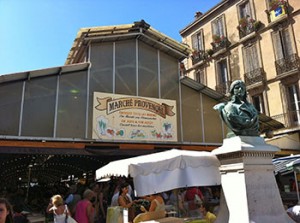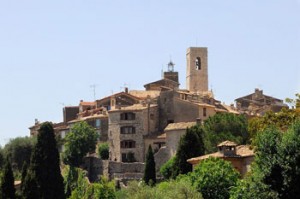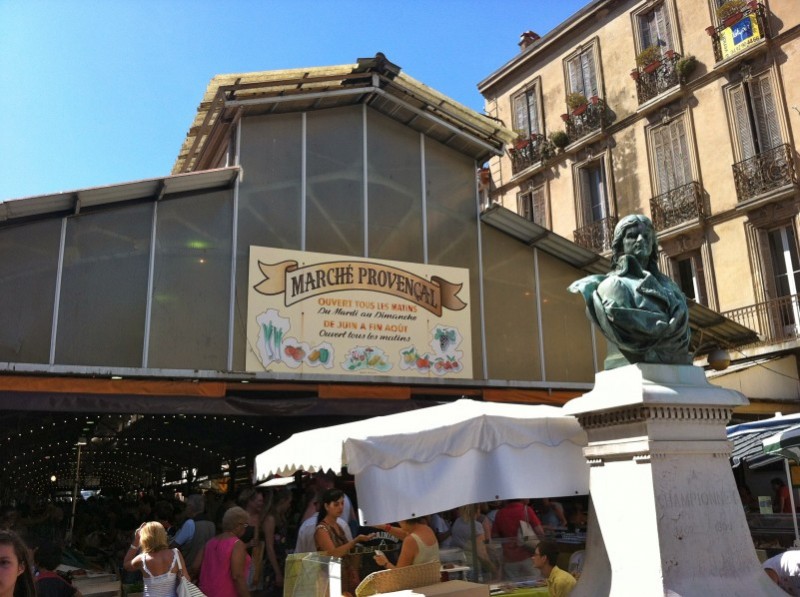A few hours after the Moccio family arrived from Toronto, Stephan and I stood at the meat counter in central Antibes’ Carrefour supermarket.
It was hardly the glamourous start to a Côte d’Azur holiday you’d expect for the guy who, just days before, was personally greeting and playing piano for the worlds’ head honchos at the G20 dinner in Toronto. Barack and Michelle, Nicolas and Carla, Silvio, Angela, Dmitry Medvedev, Hu Jintao, Cristina Kirchner, Jacob Zuma, Susilo Bambang Yudhoyono, Recep Tayyip Erdoğan, and King Abdullah bin Abdul Aziz are among his newest friends.
No, instead of soaking in the rays on some trendy beach, Stephan Moccio spent his first afternoon in the French Riviera chatting with Carrefour’s butcher, a young man wearing a white smock and wielding a convincing knife. As he wrapped up bits of pure beef for Stephan, the butcher labeled our pianist-composer friend (who I wrote about in Maclean’s magazine) as un cousin. The French adore the Quebecois like Stephan – and his accent gave him away in an instant.
Our musician friend then handed the butcher a package of pre-wrapped chicken breasts. Could he dice these, too, with his clean knife? Stephan didn’t mention the cross-contamination he was trying to avoid.
No problem for un cousin! The butcher declared his love for the most famous French-Canadian, Celine Dion. Stephan mentioned the hit song he wrote for her. It was the beginning of a friendship that would flourish during the Moccios’ two-week stay at Bellevue.
It was simple, unassuming peanuts that brought these two men together.
Philippe and I have welcomed oodles of visitors to Bellevue over several years, but we’ve never dealt with a nut allergy in France – much less over an extended period. Stephan and Hilary’s daughter Elle Sophie, a gentle and engaging five-year old with sparkling brown eyes and cascades of curls, has this allergie mortelle – an anaphylactic (or fatal) peanut allergy.
No peanuts – not even a trace of them – can enter her mouth.
Peanut allergy is hardly uncommon in the US and Canada, particularly among children. Health Canada estimates that up to 6% of the country’s children, and 3 – 4% of its adults, are affected by a food allergy, with peanuts being one of the largest contributors. The Food Allergy and Anaphylaxis Network says that peanut allergy doubled in US children over the five years to 2002. And there’s no known cure.
Like any food allergy, peanut allergy is life-altering – for everyone involved. The Toronto school where Elle Sophie and our daughter Lolo attend allows no outside food, even for birthdays. Nut-free cupcake shops have sprung up around town and do thriving business. And now our kitchen in Antibes had to be peanut-free, too.
“We used to lead normal lives,” Stephan told me that first afternoon as we waited on the butcher. With peanuts outside his lens, I bet his first holiday visit would’ve been to a fashionable stretch of sand.
In France, on the other hand, hardly anyone discusses peanut allergy. According to L’Allergie Alimentaire à l’Arachnide, a February 2005 study of peanut allergy at the Université Paris XII – Val de Marne, this allergy is increasing rapidly in France, especially in children – but today it still touches only 0.5 – 0.7% of the population.
As such, there’s little awareness here of the peanut issue. Restaurants aren’t used to discussing it. Ditto schools. Two years ago when Lolo attended École St-Philippe in neighbouring Juan-les-Pins, parents coordinated daily snacks for the 33 maternelle classmates with little guidance. Birthdays, practically a weekly celebration, were studded with chocolates and munchies that would’ve been riddled with horror for any nut allergy sufferer.
In fact, I was so clueless about the issue that for Lolo’s fourth birthday party here in France, I prepared peanut butter and jelly sandwiches – an unusual, American treat – for her little invitees. Philippe and Lolo, my peanut butter gourmands, bought into the idea and agreed to share their precious jar of imported, Skippy’s smooth for the party. (Personally I cannot stand the stuff.)
I still remember one little guest Lisa, at the encouragement of her mother, politely placing a dolly sandwich of PB and J on her plate. The four-year old looked up at me with enormous green eyes and then wrinkled her nose. “Qu’est-ce que c’est ça?” What’s that?
I’m genuinely happy to report that no one discovered a peanut allergy at that party. (Truth be told, no French person actually liked the sandwiches either.)
But now, with the arrival of Elle Sophie at Bellevue, our family suddenly faced this North American overlay – the peanut allergy – in France. Surely there’d be little problem, Philippe and I had advised the Moccios as they planned their trip. Everything is locally grown. Locally prepared. There are fewer processed foods in France.
But days before Elle Sophie’s arrival, a quick survey of the local supermarket’s plain chocolate bars – ones we’d use for s’mores or frozen banana treats – warned otherwise. The peanut issue would be less straightforward than we’d hoped.
Elle Sophie scored the top shelf in Bellevue’s refrigerator, where her food remained segregated from the rest. Her stockpile contained those meats from the Carrefour butcher, along with eggs, vegetables, goat milk, prepared couscous salads – every morsel handpicked by her parents. Her meals would be different from ours.
It had to be that way – and we understood completely. Our family doesn’t deal with a fatal food allergy. I can hardly imagine the endless worry and responsibility of those who do.
A couple mornings later as I dressed Lolo in her bedroom, a cloud of garlic wafted in. Beneath her room lies the kitchen. We went to investigate. Stephan was stirring the contents of a frying pan on the stove.
“We’re not usually this hardcore,” he said, but the family had a long day’s car journey ahead, and Elle needed something to sustain her: eggs, mushrooms, a couple cloves of garlic and – what are those green bits? I asked. Hilary produced a bag of dried kale chips that she’d brought in her luggage from Canada.
Stephan hovered over his daughter’s bowl and tasted the concoction. “It’s delicious!” he said.
Yes, sure, but for breakfast? And for a kindergartner? (Until that moment, I’d thought I was the difficult parent, allowing Lolo only half a bowl of chocolaty Chocapic cereal for breakfast and insisting that the remainder be sensible.)
The Moccio family straddled two worlds during their first week of holiday: the intensity of hometown Toronto, a place of work and hub of peanut-sensitive consumers; and the anything-goes of Antibes, a Rivieran town where a constant hum of cicadas serenades beachcombers and “peanut” is hardly an offensive word.

Leaving this charged world behind – even when he wanted to – was particularly difficult for Stephan. Shortly after arriving in Antibes, he, Hilary and Elle Sophie strolled through the Marché Provençal to pick up some produce and local foods. As Stephan handed the burly cheesemonger a EUR 50 note, a middle-aged woman approached him.
I’m so sorry to bother you, she said, but I can’t help it…. You’re Stephan Moccio, right?
Stephan nodded. The woman lived in Ottawa. She’d just seen his piano concert. She was a fan – and what do you know? Here was Stephan Moccio, the real deal, right here in the produce market of Antibes, France! Could she please have his autograph?
A Frenchman overheard Stephan’s name. He was a fan, too. He’d listened to Stephan’s music for a couple years now. How about another autograph?

The cheesemonger wanted Stephan’s attention, too. Your change, Monsieur! Your change!
It’s difficult to be seduced by the Côte d’Azur, to come fully under its carefree spell, when the real world comes along on the journey. Unsurprisingly in hindsight, it was during this more intense half of the Moccios’ stay that Elle Sophie ate from her shelf in the refrigerator – supplemented by dried kale chips, quinoa sticks, peanut-free chocolate and other goodies that Hilary had packed in her suitcase. Restaurant food was cooked ultra-simply, as prescribed by her parents.
And no bread. Definitely no bread for Elle. No pastries or ice creams. Even gelato was a risk. As restaurant and gelateria owners weren’t used to the peanut issue, they erred on the conservative side. Elle Sophie forewent – necessarily so – but she also missed the gourmand experience that makes France, well, France.
Midway through the Moccios’ stay, Philippe and I offered to cook one evening. We’d do our best to ensure everything was peanut-free. We purchased a couple large turbots from our favourite poissonnier in Cannes. We selected des artichauts, des tomates, la salade roquette,and des coco plats (enormous green beans) from a nearby, local marché. I checked and double checked the ingredients of a box of so-called blé gourmand: 100% natural durum wheat. Everything would be cooked simply, using only water and olive oil. Elle Sophie could eat what we ate.
All that remained was the question of bread, the staple of any real, French meal. I headed into Boulangerie Hasselbach, a favourite, family-owned boulangerie in Old Antibes. Unusually for this bakery, no one queued behind me as I made selections.
One of my guests, I explained to the young attendant, has un allergie mortelle aux cacahuetes. Aux arachides, I said, using the alternate word for peanuts. Were Hasselbach’s baguettes peanut-free?
“Je ne comprends pas,” she said.
Of course. When an answer isn’t readily available, no French person understands my French. I explained again, more slowly, more loudly. A queue began to form behind me.
Eventually the young woman made a phone call. Indeed, everything at Boulangerie Hasselbach was peanut-free, she reported. I smiled at ten waiting customers as the attendant wrapped two baguettes à l’ancienne and tartes aux abricots.
That night, Elle Sophie had turbot. She ate blé and coco plats – and her first morsel of French baguette. And I sighed in relief.

The next day the Moccios headed to the artsy, medieval town of Saint-Paul de Vence, about 45 minutes’ drive from Bellevue. At the very peak of this perched, stone village is a church. Across from the church is a gelateria. The Moccios knew disappointment, but it was becoming hard to bear – particularly as the bad news always hit their five-year-old daughter the hardest. Stephan entered the store alone.
Is your gelato peanut-free? He was ready for the usual ho-humming.
It was. The gelateria owner was delighted to report there were absolutely no peanuts in his shop and, in fact, a Canadian family had asked him that very same question one day earlier.
Stephan barely let the man finish his sentence. He bounded out the door and urged Hilary and Elle Sophie into the shop. As the curly-haired girl let the sweet coldness melt on her tongue, she asked her parents quite simply, “Can we drive here every day?”
Buoyed by success, we dined out that evening at Crêperie du Port in Old Antibes. I’d asked about peanuts when making the reservation. Stephan checked again on-site.
No, the crêperie folks insisted, there were no peanuts in their shop (though Stephan and Hilary spotted Nutella, the chocolate-and-hazelnut spread that’s married to crêpes like jelly is to peanut butter).
Pedestrians streamed past our outside table in the cobbled street. Stephan sucked in the cooler night air and flushed it out of his lungs. It was as if he finally was allowing the essence of the Med to soak into his big-city psyche. The charm had begun to work.
“Je suis Antibean,” he said airily.
It sounded a bit like he dubbed himself an amphibian, but Philippe and I understood. Stephan began to feel like someone from Antibes. Like a real Antibois. He belonged here.
“Antibes, je vous aime,” he said, stretching his hands upward in a theatrical plea to the night.
As Stephan – Hilary, too – began to relax into the Côte d’Azur’s arms, they began to trust the area with peanuts, too. Not in an irresponsible way, never, but as their comfort level increased, so did Elle Sophie’s culinary adventures.
The sparkly-eyed girl ate a spinach and cheese crêpe that night.
The next morning Philippe and Stephan scooted out to our neighbourhood Boulangerie de l’Ilette. No peanuts in their shop, they said. The men returned to Bellevue with pains au chocolat, brioches aux raisins, une brioche au sucre, un croustillant aux pommes, and about two dozen choquettes – small, lightly-glazed puffs of French pastry encrusted with nuggets of sugar.
Elle Sophie tasted a choquette. Her dark eyes, already sparkling, could have illuminated the boulangerie’s entire wall of ovens.
That night Chef Emmanuel took up residence in Bellevue’s kitchen. I’d already explained the peanut issue to him – several times. He always told me not to worry. He didn’t cook with peanuts. Even his chocolate, he said, was just chocolate. Pure chocolate.
As we sat for our meal, Hilary launched the bread question. Did the chef know whether the baguette was peanut-free – meaning, devoid of all peanut traces?
Emmanuel grinned. “Mais, c’est la France!” he said. We don’t put peanuts in bread! He was amused by this endless discussion about peanuts.
Hilary persevered. But the boulangerie where you bought it – is it peanut-free?
Emmanuel shook his head. He’d never asked that question. The French aren’t used to dealing with this issue, he said – or as he was implying, this non-issue. “C’est la France!” he said again.
I am sure Elle Sophie missed out on baguette that night. But she did dive into Chef Emmanuel’s most decadent and intense chocolate tarte. And it was legendary.
At bedtime, Hilary asked Elle her favourite part of the evening. There were many highlights. Elle Sophie put her own timeframe on the question. “The sugar breakfast,” she said. Les choquettes. Emmanuel’s chocolate tarte came a close second. The girl with the peanut allergy had tasted her first French pastries, and they were unforgettable.
Les choquettes became a ritual during the Moccios’ last days in France. We mourned Friday when the boulangerie didn’t bake them. Come back tomorrow, they advised. We did – and bought out their supply.
The following day Elle Sophie (reluctantly) returned to Toronto. Today she serves as the city’s most compelling advertisement for fresh French pastries.
My own revolution has been more subtle. From here on, I will praise the simplicity of food in France – its freshness and its lack of industrial processing. And whenever I am fortunate to taste the luscious sweetness of a fresh choquette, I will do so thinking of Elle Sophie – and the extra sparkle in her brown eyes.
My new awareness of nuts in France will hardly go to waste either. Just a few days ago I corresponded with Kathleen, another Toronto friend. She and her family will visit us at Bellevue tomorrow. As an afterthought – just to be sure – I launched the allergy question.
None in her family, she told me. Except for seven-year-old Veronica.
She’s allergic to peanuts.


Thanks for this post. I am planning a trip to France with my 13 year-old daughter who is allergic to peanuts and tree nuts. Even in the US, there are people who do not understand how serious the allergy is for families who deal with it daily. We are spending time in Reims and Paris.
Merci for writing, Chris. I wrote this post several years ago, and generally speaking, I believe there is a better awareness of allergies in France as each year goes by, but still the prevalence and precautions are nothing like what we know in North America. Still if you learn those few critical phrases in French and stop to explain the issue, as you would anyway, I do trust your daughter will be safe. Have a lovely time on your trip. – Jemma